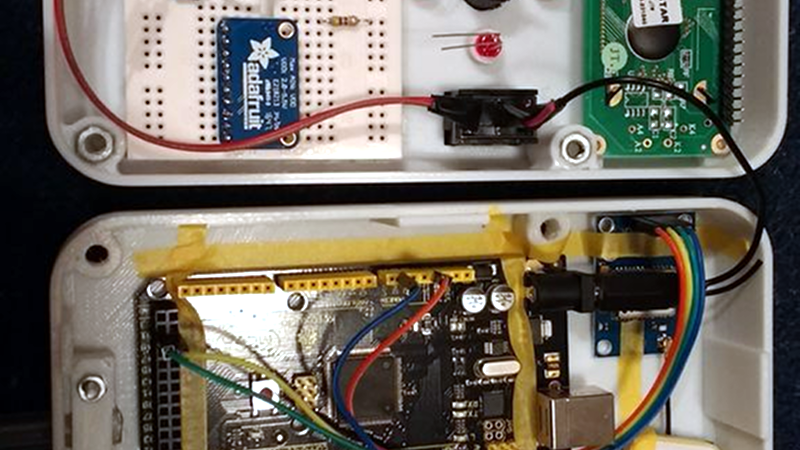Space is big. Really big. Yet on TV and movies, enemy spacecraft routinely wind up meeting at roughly the same spot and, miraculously, in the same orientation. If you’ve ever tried to find something smaller than the moon in a telescope, you’ll appreciate that it isn’t that easy. There are plenty of tricks for locating objects ranging from expensive computerized scopes with motors to mounting a phone with Google Sky or a similar program to your telescope. [DentDentArthurDent] didn’t use a phone. He used an Arduino with an outboard GPS module.
You still have to move the scope yourself, but the GPS means you know your location and the time to a high degree of accuracy. Before you start an observing session, you simply point the telescope at Polaris to calibrate the algorithm, a process which in the northern hemisphere is pretty easy.
The telescope in question is a Dobson, so is easy to move and easy to sense its position using potentiometers and an A/D. The project also includes a detailed description of the math used to convert the time, latitude, longitude, right ascension, and declination into position data. One of four LEDs show if you should move up, down, left, or right. When you are on target, all four LEDs light. We assume you should use red LEDs and a red LCD filter so you don’t ruin your night vision.
There are a few sources of error and [Arthur] does a great job of analyzing and correcting each one. The project even has a nice 3D printed case. The database only contains 45 objects but it is easy to add more. We wondered if it wouldn’t have been better to use a larger computer such as a Raspberry Pi to get the stellar data — maybe even from the Internet — and rely on the Arduino to just manage the position sensing and direction indication, but then again, this works and it is very inexpensive.
This isn’t the first Arduino telescope finder we’ve seen. The last one even had a touchscreen.















Has anybody taken this to the next level by using an IMU (like an MPU9250) instead of potentiometers that you’ll have to attach to your telescope? You point to Polaris for IMU calibration and go from there?
Production systems out in the field which consist of a ratsnest of DuPont-style jumper wires plugged into Arduinos and breadboards, with absolutely no proper connections?
:'(
Learn to use proper connectors and solder, people. You’ll thank me when you’re debugging / fixing the thing later.
I lost the red-dot on my telescope. now I just kinda put my eye as close to the tube as I can, aim up Jupiter or the Orion Nebula, then look through the eyepiece. If I missed, I do a spiraling outwards search pattern. It’s really not that bad. Plus learning where things are in the sky is most of the fun of astronomy (for me anyway). My next scope is going to be an 18 inch dob, and without motors and go-to systems, I can score it for under $1k from a reputable company. A similar sized scope with all the go-to capability and motors is over $3k.
“I can score it for under $1k from a reputable company.”
[citation needed]
B^)
I was inspired to Google for a few minutes.
From Obsession, whose reputation I know: $6995.
Cheapest complete 18″ Dobsonian I found: $3295.
Cheapest just-a-mirror-blank-lots-of-work-to-complete-the-telescope I found: $1785
So, either a typo or [j0z0r]’s source for cheap light buckets could use some SEO.
https://www.highpointscientific.com/telescopes/reflecting-telescopes/high-point-dt12-classic-dobsonian-telescope-kit-dt12
12 inch for $730. That 18 incher might have been a deal or a sale, I don’t see it anymore. r/telescopes vouches for High Point scientific, says they have better optical clarity than Orion, less chromatic aberration than Meade. My current dob is an Orion 100mm, just enough to get me interested.
If you’re familiar with firearms, you might see the name “High Point” and go running, but it’s not the same company that makes those ugly ass guns.
For the southern hemisphere, I’m guessing a logical choice of star would be either Alpha Centauri (the brighter of the two pointers) or Alpha Crucis (the bottom of the southern cross).
No…
You’re going to need to point it at the ground towards where Polaris would be if the Earth wasn’t blocking your view.
B^)
Attach a green laser pointer to a couple of servos
Nicely done, but needlessly complicated. If he had just come up with a way to accurately determine the scope’s azimuth and inclination there are several free or low cost aps for phone or tablet that will give the current values for objects of interest. Some amateurs use setting circles and inclinometers.
nice post